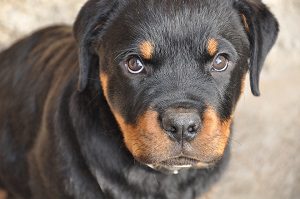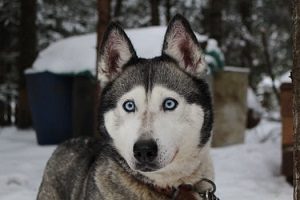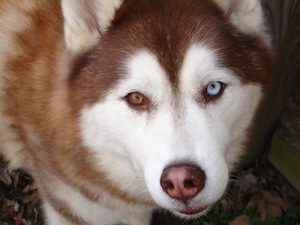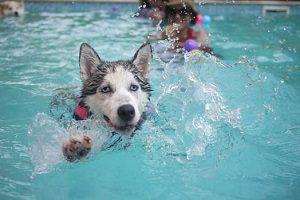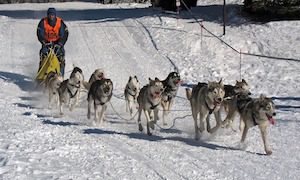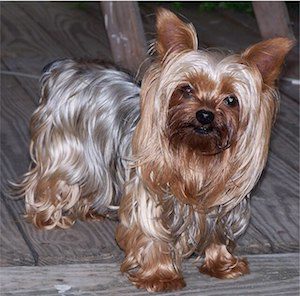Dog Breed of the Month: Poodles
August 23, 2017
Trina
If you’re looking for an energetic, kid-friendly, intelligent four-legged new member for your family, you should consider a poodle. While you may think of poodles as a Best-in-Show dog breed, they are so much more than just a beautiful dog. Poodles have a long history as water dog, a type of working dog and even their name reflects that. Poodle derives from the German word pudelin which means to splash in the water.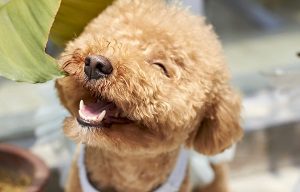
Poodle Features
According to the American Kennel Club, the three types of poodles – the Toy, the Miniature, and the Standard – are determined by their height and are not different breeds. A Toy poodle will be under 10 inches tall at the withers and weigh between 6 and 9 lbs. A Miniature poodle will be between 11 and 15 inches tall and weigh between 15 and 17 lbs. A Standard poodle will be over 15 inches tall at the withers and weigh between 45 and 75 lbs for a male and 45 to 60 lbs for a female.
Mini, Toy and Standard poodles coat colors can include black, white, silver, grey, blue, brown, cafe-au-lait, cream and apricot. A smaller poodles life span is typically between 14 and 16 years and a typical standard poodles lifespan is 12 to 14 years. No matter which size poodle you get, your new family member should be part of your life for a long time.
Poodle Temperament
No matter which one of the poodle types you choose, be prepared to spend a lot of time training and exercising this highly intelligent and high energy dog. Your poodle will learn quickly so be sure to have a training plan on hand- whether it’s one you’re in charge of or an obedience school you’ve signed him up for. Poodles pick up bad habits just as quickly as good ones so be on your best behavior around your new pup.
A standard poodles temperament is an easy one for new dog owners. They are generally sensitive and loyal, eager to please and not very aggressive. Your poodle might bark at a stranger but he’s only doing it to keep you, his beloved human, safe.
Because your poodle is so smart, he’ll need to be entertained lest he become bored and misbehave for attention. This doesn’t mean you need to entertain him 24/7 but it’s a good idea of keep some toys on hand for him to play with and to play with him when you are around. Smaller poodles especially can be great apartment pets as they’re able to get enough exercise indoors, running around your room or down hallways.
Poodle Grooming and Maintenance
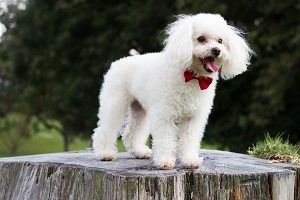 Like human hair, poodle fur never stops growing so be prepared to regularly groom your poodle every three to six weeks. If you’re an allergy sufferer, you may be wondering Do poodles shedThe answer is yes, but most of their fur collects in their coat, requiring you to brush them daily to avoid matted fur. Poodles are one of the most hypoallergenic dog breeds out there and poodles are often crossbred with other dogs. The most common poodles crosses are with cocker spaniels, malteses, labradors, golden retrievers and yorkies.
Like human hair, poodle fur never stops growing so be prepared to regularly groom your poodle every three to six weeks. If you’re an allergy sufferer, you may be wondering Do poodles shedThe answer is yes, but most of their fur collects in their coat, requiring you to brush them daily to avoid matted fur. Poodles are one of the most hypoallergenic dog breeds out there and poodles are often crossbred with other dogs. The most common poodles crosses are with cocker spaniels, malteses, labradors, golden retrievers and yorkies.
Traditional poodles grooming styles were due to their history as a water dog. Their fur needed to be trimmed so it wouldn’t weigh them down in the water but would still in insulate their bodies in the cold water. Your poodle does not have to look like a water dog or a show dog though. You can easily groom him to look like a normal dog.
Poodles do gain weight easily and will often devour everything in their bowl so it’s best to feed your poodle smaller portions twice a day and ensure he is getting plenty of exercise. Don’t leave food just sitting in his bowl or feed him table scraps, despite those pleading looks he’s so very good at giving you.
As with most breeds, poodles do have some genetic health issues you should watch for. Addison’s Disease, epilepsy, thyroid issues (both hyperthyriod and hypothyroid) and Progressive Retinal Atrophy are all issues your vet should regularly ensure your poodle doesn’t have. While this list seems long, poodles are generally a very healthy and sturdy breed so don’t panic that your new family member is going to fall terribly ill.
Poodle Fun Facts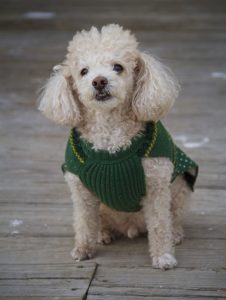
- Elvis loved poodles and gifted them to his significant others.He gave his future wife Priscilla a poodle puppy named “Honey”.
- Poodles are big sleepyheads and a standard poodle will sleep up to 13 hours a day!
- Poodles are such an old dog breed that their images are found in Roman and Egyptian art from thousands of years ago.
Whether you live in an apartment or a big home with a hard, have a large family with kids or live alone, a poodle will make a great addition to your family. This adaptable breed doesn’t need much space – just lots of love and attention.
Read more like this:
Featured DogDog Breed of the Month: German Shepherds
July 26, 2017
Trina
If you’re looking for a smart, courageous and active new member for your family, you should consider the German Shepherd. They are often referred to as the true “dog lover’s dog.” Their superior intelligence makes them easy to train and they do well in households with children. In fact, these naturally loyal dogs fit in with almost any lifestyle. The most important consideration is that these agile, muscular dogs require regular mental stimulation and physical exercise.
German Shepherd Features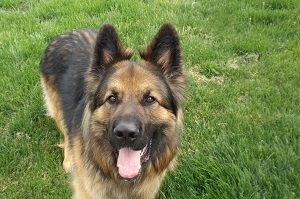
German Shepherds have a long lifespan, with some experts citing 8-10 years. Full grown males range from 24-26 inches in height and usually weigh in at 65-90 pounds. German Shepherd females are slightly smaller, usually about 22-24 inches in height. A healthy female German Shepherd weight is between 50-70 pounds. They are not generally a hyper breed and bark when only when necessary. Alertness is part of their personality and they’ll want to let you know when they spot something important you may have missed.
Mini German Shepherds are becoming popular with those who favor small breed dogs. Minis are usually German Shepherds bred with Border Collies or Poodles. If this is the case, the seller is obligated to be honest and upfront about the cross breeding. Some health issues may result from this mix. If you’re considering a Mini German Shepherd, be sure to find out what your little one’s DNA is composed of and do diligent research regarding their potential health issues.
German Shepherd Temperament
As with any other dog, temperament is a key factor in determining whether a German Shepherd will be a good fit for your family. Their protective nature and spirited disposition makes the German Shepherd an ideal guard dog. Highly intelligent, these dogs can learn many commands. German Shepherds can easily be trained for numerous canine jobs, including as a guide dog or as a therapy companion.
German Shepherd Grooming and Maintenance
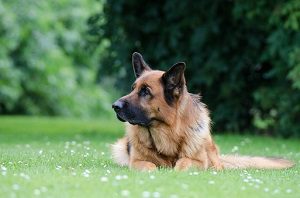 Their resemblance to wolves make for a handsome dog breed. German Shepherd coat colors and patterns range from “saddle back”, “blanket back”, and bi-colored. Some German Shepherds are multi-colored with coat hair that includes solid black, black and tan, black and silver. Another color frequently seen on this breed is a sable shade known as wolf gray. German Shepherds shed a fair amount but occasional visits to a groomer will help. Generally, these are healthy dogs with infrequent health issues. That said, you should keep an eye out for signs and symptoms of hip and elbow dysplasia and eye diseases.
Their resemblance to wolves make for a handsome dog breed. German Shepherd coat colors and patterns range from “saddle back”, “blanket back”, and bi-colored. Some German Shepherds are multi-colored with coat hair that includes solid black, black and tan, black and silver. Another color frequently seen on this breed is a sable shade known as wolf gray. German Shepherds shed a fair amount but occasional visits to a groomer will help. Generally, these are healthy dogs with infrequent health issues. That said, you should keep an eye out for signs and symptoms of hip and elbow dysplasia and eye diseases.
Experts emphasize that color and pattern are the last thing potential owners should make a fuss about. Your puppy’s vitality, good health, and athleticism are much more important. New owners are advised to realistically judge whether your household space can accommodate the needs of a German Shepherd. You should also be sure everyone in the family is prepared to feed, walk, and interact daily with this new addition.
German Shepherd Fun Facts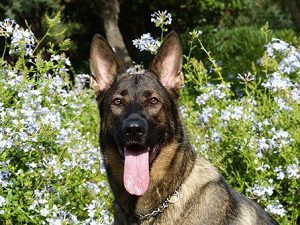
- German Shepherds became very popular in the United States in the early 1900’s in the state of Illinois.
- At the time, their popularity was boosted by the long-forgotten canine movie stars, Rin-Tin-Tin and Strongheart.
- German Shepherds are the globally preferred breed for police and military K-9 units.
- In February 2017 the Westminster Kennel Club Dog Show awarded Rumor, a German Shepherd, best in show.
A German Shepherd will consider your family and home as his pack and territory. A German Shepherd will be generally fearless and once he bonds with his humans, it’s for a lifetime. As long as you as his owner take the time to train him, to show him love and affection, and to respect your new family member, this will be a lifelong wonderful relationship.
Read more like this:
Featured DogDog Breed of the Month: Beagles
June 28, 2017
Trina
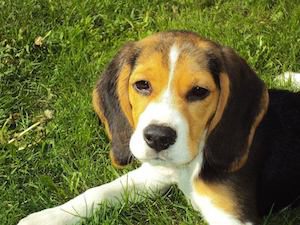 Beagles are a member of the Hound Dog family, a class of dogs historically tasked with tracking and hunting. Beagles, as we know them today, can be traced back as far as 1800’s England where they were primarily used to flush out rabbits. Their heritage has been etched into various versions of The Fox Hunt paintings, depicting the hunting hounds from which they descend. How many people can say that their dog’s ancestors are included in works of art that hang in museums all over the world? They made their way into American hearts when a breeder from Illinois brought them to the United States, and have since become known as one of the most loving and loyal breeds.
Beagles are a member of the Hound Dog family, a class of dogs historically tasked with tracking and hunting. Beagles, as we know them today, can be traced back as far as 1800’s England where they were primarily used to flush out rabbits. Their heritage has been etched into various versions of The Fox Hunt paintings, depicting the hunting hounds from which they descend. How many people can say that their dog’s ancestors are included in works of art that hang in museums all over the world? They made their way into American hearts when a breeder from Illinois brought them to the United States, and have since become known as one of the most loving and loyal breeds.
Beagle Features
Beagles typically grow to between 20 and 30 pounds. Most have a short, smooth tri-color (white, black & tan) coat, but two-color coats (usually white & tan) are not uncommon. Some tri-color beagles will lose their black markings as they age. They are also bred in two different sizes and both can be present in the same litter, so if you’re intent on one over the other, you’ll need to wait about nine months to bring home your newest member of the family.
Beagle Temperament
Beagles are an affectionate and loyal breed, making them excellent family dogs. Along with loyalty though, can come some pretty stubborn behaviors.
As with most hunting dogs, their sniffers are the center of their universe. As such, they can override everything at times. Yes – even the repeated and reasonable requests of their parents! Most trainers with experience will tell you that the key to working with beagles is to make everything into a game, enabling you to hold his attention long enough to learn what you’re asking of him.
Beagles are a pack breed and typically become very attached to their humans. As such, they are an excellent addition to families with children.
If you’ve done any research into beagles at all, you’re probably aware of the fact that they love to “talk”. Their reputation for being vocal leads to some common concerns on the part of potential owners. Do they bark a lot? Do beagles howl? The answer is that they do employ some very distinct sounds, from barking to braying, for different situations and yes, they do like to howl. They also love food, even more than most dogs. For these reasons, you’ll need to keep a vigilant eye to be sure “people food” is kept out of your beagle’s reach. On the flip side, their love of food can be a plus when training. A beagle will do just about anything you ask if you’re holding a treat.
All of these potentially negative tendencies can be curbed simply by making sure your beagle is never bored. Having a household with children or another dog to play with and plenty of toys is a happy place for most beagles.
Beagle Grooming and Maintenance
It’s critical to remember that as hunting dogs, beagles definitely need their exercise. You’ve no doubt encountered those poor pups that are cooped up in apartments and have “put on the pounds” as a result. If you’re interested in owning a beagle, please be sure your lifestyle can accommodate frequent walks or your budget can accommodate a regular dog walker. When can you carve out the time, a walk with a beagle is typically a very relaxing experience for the parent on the other end of the leash. Beagles live to investigate the world through smell, so you can expect long casual walks with lots of stops along the route.
A fenced-in or perimeter-controlled yard or an off-leash dog walker is also a must! The inner hunter loves to explore and their sniffers will lead them away in a single-minded chase if they’re not in some way prevented from doing so. That same one track mind can also lead to selected listening, so don’t hold it against him if he’s too busy tracking to come to your calls.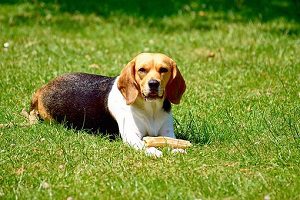
Like many breeds, beagles do have a few genetic health issues to keep an eye out for as your beagle ages. Among them are hip dysplasia, diabetes and seizure disorders. It’s impossible to tell whether or not these are areas of concern for a particular puppy, so it’s important to ensure your chosen breeder is reputable and has solid references.
Do beagles shed a lot? While they do shed year-round, a good brushing a couple of times a week will keep the household “fallout” to a minimum. In general, beagles definitely fall on the low maintenance side of the grooming spectrum.Unless he’s found something fun to roll in, a bath every three months or so should be sufficient. Along with their cute floppy ears, comes a heightened responsibility to keep them clean. Finally, as with most breeds, you’ll need to keep his nails trimmed to the point where you can’t hear them clicking on the floor.
Beagle Fun Facts
- Beagles are frequently employed by the US Department of Agriculture. They undergo a three-month training program and help to patrol airports across the country for weapons, drugs, and foods that could carry dangerous insects or diseases.
- While your beagle will undoubtedly be the world’s most adorable, they still have some famous shoes to fill. Beagles have roamed the grounds of the White House and are a huge part of popular culture. Snoopy (Peanuts), Mr. Peabody (Rocky and Bullwinkle) and Odie (Garfield) are some of their more famous tinsel town extended family!
When you bring a beagle home, you are literally adding a new member to the family. He will become fiercely attached to his new pack, so please be confident in your decision. Just like many humans we all know, he can be stubborn and willful. That dedication and enthusiasm will also shine in his love for you, though. Would we really want it any other way?
Read more like this:
Featured DogDog Breed of the Month: Rottweilers
May 24, 2017
Trina
Rottweilers are a member of the Working Breed Group. Like most members of this group, Rottweilers are uncommon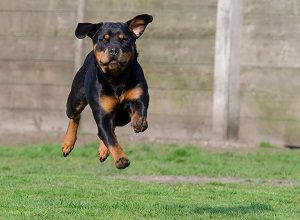 ly intelligent and loyal. Other shared traits include their large size and formidable strength. The rottweiler’s history can be traced back to early Roman times where they were originally bred to herd cattle and pull farm carts. Later, they were taught to perform more aggressive duties such as bear hunting, if you can believe that!
ly intelligent and loyal. Other shared traits include their large size and formidable strength. The rottweiler’s history can be traced back to early Roman times where they were originally bred to herd cattle and pull farm carts. Later, they were taught to perform more aggressive duties such as bear hunting, if you can believe that!
Rottweiler Features
Given the right circumstances, rotties can grow to be more than 100 pounds. The rottweiler’s short and smooth fur accentuates an already muscular frame, leaving an intimidating impression on most. Their imposing size, combined with their distinctive black-and-tan coloring, makes them one of the most recognizable breeds.
Rottweiler Temperament
Proper breeding and training are a must when considering a rottweiler for your family. Unfortunately, occasional misguided and uneducated training has left them saddled with an unfair reputation. That being said, as a rottweiler owner you are taking on a serious responsibility. Any dog, especially one with the size and strength of a rottie, warrants respect. However, the loyal and protective nature of these dogs demand extra care and caution in their training.
Rottweilers are uniquely dedicated to their family, but it’s not uncommon for them to bond with others they are frequently exposed to as well. On the same note, they’ve also been known to attach themselves more strongly to a single member of the family. Most are very loving and can’t wait to cuddle. Like people, they do have very distinctive personalities and tendencies. You should be prepared for each of these eventualities presenting itself and possibly differing even within the same litter.
Are rottweilers good with kids? Absolutely, but while they will bond quickly with your children, it would be short-sighted to assume your rottie will deal with other children the same way. His protective nature could interpret normal play behavior between children as a threat to those he loves, posing obvious behavioral risks. His heritage as a herder can also pose challenges in homes with small children or the elderly. At more than a hundred pounds, what he sees as a playful nudge can end badly for someone with balance issues. Certain rottweiler traits can make a rottie a great part of your family when he is raised properly, but rottweilers do require an extra level of vigilance on the part of their humans. For these reasons, you should strongly consider professional training.
The breed isn’t normally known for being very vocal, so your rottweiler’s barking should be investigated. Chances are he’s spotted something he perceives as a threat to his humans. As such it warrants your attention either to address the issue or to let him know all is still right with the world.
Rottweiler Grooming and Maintenance
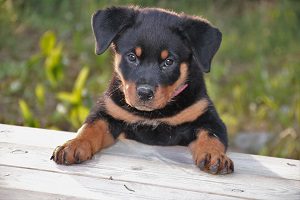 Many people stereotype rottweilers as single-minded guard dogs when the opposite is true. Rotties are very much a thinking breed, so it’s critical to remember that they are happiest when they have a job to do. In addition to a normal walking schedule, it’s especially important to play games with your rottie. Playing fetch or hide-and-seek with your pup frequently will make him feel like a valued member of the family. He needs a sense of purpose so even during those unavoidable busy stretches in your life, be sure to at least run him through his set of learned commands on a daily basis.
Many people stereotype rottweilers as single-minded guard dogs when the opposite is true. Rotties are very much a thinking breed, so it’s critical to remember that they are happiest when they have a job to do. In addition to a normal walking schedule, it’s especially important to play games with your rottie. Playing fetch or hide-and-seek with your pup frequently will make him feel like a valued member of the family. He needs a sense of purpose so even during those unavoidable busy stretches in your life, be sure to at least run him through his set of learned commands on a daily basis.
Rottweilers have what is known as a double coat. They have a dense outer coat and a softer undercoat around the neck and thighs, the thickness of which can change depending upon the climate he lives in. Do Rottweiler’s shed? They do, most heavily during Spring and Fall, so it’s important to brush him at least once a week during those seasons. Bathing requirements are more relaxed though. Depending on personal preference, you can bathe your rottie only when he’s noticeably dirty or as often as weekly without damaging his coat.
Rotties do slobber, especially while drinking or immediately following a meal. Some extra care around his feeding station and environment can mitigate this trait though.
Their average weight and their genetic characteristics leave them vulnerable to hip and elbow dysplasia. They are also prone to obesity, which accentuates the risk of the former. Thankfully, obesity is the one thing you as his human can easily protect him from by taking it into account when figuring out his diet. A rottweiler’s life expectancy is typically 8 to 10 years. Caring for their unique needs will help to protect them from avoidable health issues and ensure many happy memories!
Rottweiler Fun Facts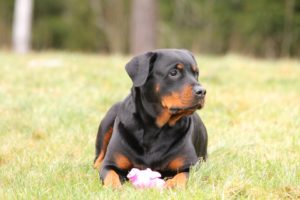
- A rottweiler’s bonding tendencies and protective nature earn them a place near the top of recommended breeds to serve as service dogs and they’ve even been employed in search-and-rescue roles.
- At one point in their history, the rottweiler was actually at risk of extinction. When cattle driving was briefly outlawed in Rome and they were replaced by donkeys as the prefered carting animal, their numbers fell dramatically. If not for the quick thinking of a club formed to protect the breed in the early 1900’s, we might have lost the breed forever.
Rottweilers aren’t for everyone, but their protective nature and strong bonding traits are obvious draws for many families. What sometimes gets overlooked though, is the deep and intricate nature of a rottweiler’s personality. Don’t be surprised if you observe a sense of humor in your pup. He is eager to please and impress and will even resort to what could be considered “goofy” behavior if he senses someone could use a pick-me-up. Bringing a rottie into your home is like adding a family member in every sense of the phrase!
Read more like this:
Featured DogDog Breed of the Month: Siberian Huskies
April 19, 2017
Trina
If you shouldn’t judge humans by their physical appearance, you also shouldn’t love a dog based on their coat. However, it’s hard not to fall in love with a Siberian Husky, which has one of the most gorgeous, thick coats among the many dog breeds. Affectionate and kid-friendly, these dogs also tend to break the stereotype of large-looking dog breeds being noisy and unsafe. For this alone, the Siberian husky deserves to be the dog of the month.
What Is a Siberian Husky?
Based on its medium frame, you would immediately guess it’s a guard dog. You’d be wrong. The Siberian Husky is a sled dog, along with its relatives which include the Greenland Dog, the American Eskimo dog, the Labrador Husky, the Alaskan Malamute, and the Akita.
The history of these huskies began around 3,000 years ago in a Russian peninsula where the Chukchi people lived. The Chukchi tribe is nomadic, and they live mostly by hunting and gathering. To help them navigate through thick ice, they rely on Siberian Huskies. For this reason, Siberian Huskies are also called Chukcha dogs.
The breed arrived in North America, particularly in the United States, during the early years of the twentieth century when they competed in the All-Alaska Sweepstakes races. About 21 years later, the American Kennel Club (AKC) recognized the breed.
Siberian Husky Appearance
Most people think Siberian Huskies are either black or white with few markings on the heads and that they have the most gorgeous set of blue eyes. These dogs, in reality, can come in a wide variety of colors that include reddish brown (sable), cream (agouti), pale yellow to light orange (light red), dark red (copper), and gray (wolf gray). Their eyes can also be brown and some Siberian Huskies have both brown and blue eyes. Oddly, some Siberian Huskies can be parti-eyed, which means their eyes can have two colors.
They are generally medium framed and can measure up to 23 1/2 inches at the withers (female dogs can be smaller by an inch) and weigh between 35 and 60 pounds, depending on the gender. Although the body appears stocky, Siberian Huskies generally have a proportional height and weight.
One of its main features is its coat. The undercoat is dense while the top coat is smooth, making the Siberian husky really fluffy and furry.
Siberian Husky Temperament
Siberian huskies can have the loudest barks and strongest growls, but overall, they are incredibly affectionate and lovable. After all, their ancestors used to sleep with the Chukchi families, especially their kids, to help them keep warm. Yet unlike other affectionate breeds, they are independent. As they can take their independence seriously and wander, you need to be aware of where they are, especially in areas with high traffic. Siberian Huskies generally get along with other dog breeds, other animals, and other people, which means you shouldn’t expect this dog to guard your home.
Based on their ancestry, Siberian Huskies are active, alert, and agile. They are the perfect personification of endurance but because of these same characteristics, they require a lot of space to move around, making them not suitable for apartment dwelling.
Siberian Huskies are fun dogs, and they definitely love to play. But since they are independent and don’t require your engagement to be happy, they can have issues with obedience. It’s not impossible for them to go back to their original habits after training, so you need to be very patient with them and keep the training constant.
Siberian Husky Health and Grooming
The amount of hair they shed depends on the climate you’re in. If you live somewhere tropical or humid, especially during spring and summer, expect to deal with a lot of hair. However, if you live somewhere more temperate, like the Bay Area, you won’t have as much clean-up to do. No matter the climate, a Siberian Husky’s coat requires weekly grooming and daily brushing of the coat.
Siberian Huskies live an average of 12 to 15 years, but they’re not prone to a lot of health issues. Some of the common diseases that can develop among the breed usually affect their eyes such as glaucoma and progressive retinal atrophy. Bigger health issues are not common.
Siberian Husky Fun Facts
- Siberian Huskies played a huge role in treating diphtheria that struck Nome, an Alaskan village, in 1925. A team of Siberian Huskies traveled more than 600 miles in six days to get the much-needed serum from a train stop in what is now known as the Great Race of Mercy.
- One of these heroes, Balto, is now immortalized in Central Park.
- The color of their coat determines the color of their nose.
- These dogs hardly smell, and they don’t require much bathing.
Siberian huskies are not for everyone. Their self-sufficiency and independence may frustrate first-time dog owners while their size and need for large spaces may demand a more spacious dwelling. But these potential downsides pale in comparison to the sweetness, affection, friendliness, and gentleness this dog exhibits. They don’t require extensive grooming and their sense of endurance make them even more worthwhile pet companions. So don’t hesitate to rescue or adopt a Siberian Husky. You may have to put some work into training etc for a while, but the rewards for your effort will be repaid in spades.
Read more like this:
Featured DogDog Breed of the Month: Yorkshire Terriers
March 22, 2017
Trina
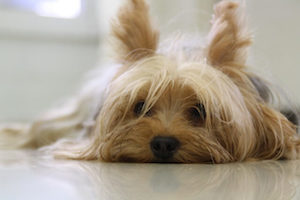 Yorkshire terriers, also known as Yorkies, come from the Terrier family, which also includes Airedale, Boston, and Jack Russell Terriers. Their history traces back to England in the early 19th century. They were bred not to as companion dogs but as hunting dogs. These pooches, lovely as they are, excel at catching rats and other vermin. For this reason, terriers re classified as hunting dogs, although today Yorkies are either companion or toy dogs, depending on the dog club.
Yorkshire terriers, also known as Yorkies, come from the Terrier family, which also includes Airedale, Boston, and Jack Russell Terriers. Their history traces back to England in the early 19th century. They were bred not to as companion dogs but as hunting dogs. These pooches, lovely as they are, excel at catching rats and other vermin. For this reason, terriers re classified as hunting dogs, although today Yorkies are either companion or toy dogs, depending on the dog club.
Yorkshire Terrier Features
Back in the day, Yorkies were categorized by the length of their legs. Nowadays, it’s by their function and size. Modern Yorkies are small dogs whose weight is usually 7 pounds and below, although on rare occasions a Yorkie can weigh more than 10 pounds. Yorkies have compact bodies, short legs, and tails that can extend higher than their back. A Yorkie’s coat is long and silky. They also come in different colors such as blue and tan, black and tan, black and gold, and blue and gold.
Yorkshire Terrier Temperament
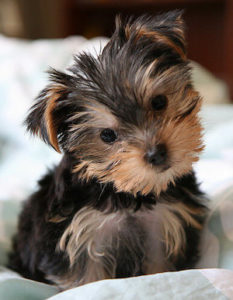 It’s so easy to fall in love with a Yorkshire terrier. From their perky ears to their bright eyes and the topknot on their heads, they appear cute and cuddly. Given their appearance, it’s no surprise that many stylish women would want one as a pet and be inclined to carry them around. Yorkies are very popular as “purse dogs”.
It’s so easy to fall in love with a Yorkshire terrier. From their perky ears to their bright eyes and the topknot on their heads, they appear cute and cuddly. Given their appearance, it’s no surprise that many stylish women would want one as a pet and be inclined to carry them around. Yorkies are very popular as “purse dogs”.
Yorkies are sweet and affectionate, which can be both a good and a bad thing. They try their best to please and entertain you and their liveliness can be contagious and uplifting. However, the same attachment and liveliness may result in a Yorkie being clingy and unable to be left alone for long periods of time. This is especially common if the dog is groomed to be a purse dog. Yorkies are fairly high maintenance dogs, requiring a lot of attention and interaction.
Yorkshire terriers are sometimes called big dogs in small bodies, particularly because they haven’t completely lost their terrier heritage. As hunters, they are adventurous and excitable, so they tend to have boundless energy. They are known for their loud barks when they encounter strange people and animals, and there are times when they can be aggressive. Yorkies are also sensitive creatures, which means they can easily perceive your emotions so if you are a sensitive soul, you might appreciate a Yorkie as a pet.
Lastly, like the other members of the Terrier Group, Yorkies can take some time to train since they can be stubborn. Nevertheless, they are intelligent dogs and will learn quickly when they feel like it.
Yorkshire Terrier Grooming and Maintenance
Even though they’re small, they can live for as long as 12 years, but as a pet parent, you need to watch out for their common health issues such as hypoglycemia, which can occur during the first few months of their life. This condition means a sudden drop on their sugar level that can result in drowsiness, muscle weakness, and, rarely, a coma. They are also susceptible to irregularities of the retina (retina dysplasia), dislocation of the kneecap (luxating patella), and Legg-Parthes disease.
Because of their coats, Yorkies need to be groomed regularly, usually once every three weeks. You have the option to either cut or knot the long hairs on your Yorkie’s head to make sure they don’t get in the way of your dogs vision. It’s also important that you brush your dog to detangle his coat at least once a day, as well as wipe his coat with urine remover as the waste can collect on their coats.
Although Yorkies are small, they do require daily exercise because they tend to have a lot of pent-up energy. If this energy is not released, a Yorkie may only become aggressive, put on excess weight, or bark loudly. The good news is they are normally fine with a brisk walk around the neighborhood or on an off-leash adventure with other dogs.
Yorkshire Terrier Fun Fact 
- Unlike most other dogs, they have hair, not fur, which means they don’t shed and are hypoallergenic.
- Smoky was the first therapy dog. She played a huge role during World War II, first as an aid to stringing communication lines for the soldiers in the trenches and then as an entertainer to wounded fighters in hospitals.
There’s a saying that goes “Big things come in small packages.” This is perhaps the best way to illustrate our dog of the month, the Yorkshire terriers. They are delicate, sensitive dogs that may require regular exercise, grooming, and maintenance. They have the tendency to be clingy, but if raised right, they can also surprise everyone. They can be very independent, vivacious, and happy. They can guard and protect you without even thinking about their size. The level of confidence they have will inspire you.
Read more like this:
Featured DogDog Breed of the Month: Shih Tzu
February 22, 2017
Trina
Anyone who says that shih tzus aren’t cute probably hasn’t seen one. They’re the classic—even perfect—examples of cuteness, the concrete idea of a furry best friend. They are loveable and huggable and are one of the top 20 popular dog breeds in America. Whether you’re a proud pet parent or thinking of adopting one, it’s important that you have at least a basic idea of the personality and features of the dog. With that in mind, you’ll know how to train it, make it a perfect companion, and establish an amazing relationship with your new shih tzu.
The Beautiful History of the Shih Tzus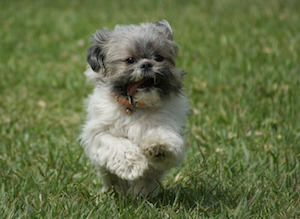
Where do shih tzus come from? If we had dependable, accurate historical records, then we could answer this question without any argument. Alas, we don’t. However, despite the murky history, we have been able to decipher some facts about the history of shih tzus.
Based on DNA analysis, these dogs belong to the “ancient ones”, the first line of dogs to have appeared on earth. Despite their diminutive size, they could be directly related to wolves!
Many believe shih tzus originated from, or at least have a strong affiliation with, Tibet and China and that their history goes back as far as 1,000 years. They say these dogs held a royal distinction—that is, they were bred and raised in palaces, especially during the reign of Empress Dowager Tzu Shi. In fact, they were so important they were not sold or traded.
So how did they end up in the West? Although they were not meant for trading, they made fantastic diplomatic gifts. Chinese royals may have gifted the European nobles with a shih tzu, just as Indian royals sent elephants and tigers to Europe..
Shih Tzu Features
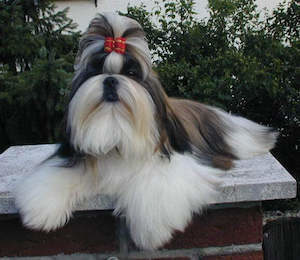 Shih tzus are well-known for their regal bearing. Although they are small, they are sturdy and confident. Per the American Kennel Club, a non-faulty shih tzu will be long and tall with no tuck-up or waist. It will not be barrel chested, but the chest area should be broad.
Shih tzus are well-known for their regal bearing. Although they are small, they are sturdy and confident. Per the American Kennel Club, a non-faulty shih tzu will be long and tall with no tuck-up or waist. It will not be barrel chested, but the chest area should be broad.
The club, which has recognized the dog breed since 1969, highlights the coat, which should be dense, double, and luxurious. Although waves are acceptable, they must not be curly. The hair on top of the head must be long enough to be put into a shih tzu topknot.
A typical shih tzu weighs about 9 to 16 pounds and stands up to 11 inches at the withers. There are many different shih tzu colors, but those that pass the standards of AKC must have black noses, eye rims, and lips.
Shih Tzu Health
A shih tzu can live up to 16 years, but can have a wide range of health issues, some of which are hereditary. Because their faces are small and their eyes are big, they are prone to different eye diseases including ulcers of the cornea, cataracts, and entropion, which occurs when the eyelids turn inwards.
They also have short noses, which can lead to breathing or respiratory problems, and since their backs are elongated, they are prone to intervertebral disk disease, which can result in coordination loss and back pain.
Shih Tzu Temperament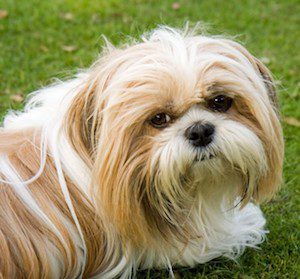
Shih tzus make great companion dogs or pets. In fact, they make great starter pets for children, although it’s best if you match kids with young shih tzus. Their energy can be boundless, and a shih tzu pupppy will be up for lots of play. They are gentle, caring, and loving, and they know how to reciprocate attention, loyal, and trust.
Despite having dense coats, shih tzus are “hypoallergenic.” Although it still sheds hair, it does so every day so there’s never an accumulation of too much hair. Small and adaptable, a shih tzu could be a good pet for city dwellers where space is at a premium. Moreover, it’s possible to leave an adult shih tzu alone for up to 9 hours. However, housebreaking can be a challenge since they tend to be stubborn.
Shih Tzu Grooming and Maintenance
Like all dogs, shih tzus require regular exercise, but as they are more of an inside dog, you can limit your activity to just a few minutes of walking daily. The bigger responsibility lies in grooming, especially the hair. Lack of grooming can result in matted hair. If you don’t have the time to brush the hair regularly, you can clip or trim it.
Shih Tzu Fun Facts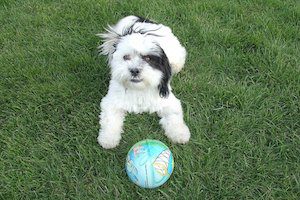
- Despite popular belief, there’s no such thing as a teacup shih tzu.
- Shih tzus are popular pets among celebrities. Even Her Majesty Queen Elizabeth II owns one..
- Shih tzus are sometimes called chrysanthemum dogs, because of the way their hair grows from the central part of the face, resembling the flower petal pattern.
- Marnie is one of the popular shih tzus on the Internet with more than 1.5 million followers on Instagram! He also has a beautiful story. Read it here.
People living in San Francisco or even in the Bay Area should who are looking for another dog should seriously consider getting a shih tzu. They are loyal and loving. They are happy dogs that will do their best to lighten your mood coming from work or a long day at school. They are willing to wait and are resilient, thriving for hours by themselves. Although there are challenges in raising them, including grooming, their long term health, and the process of house training them, the long list of benefits you get from having this royal breed as part of your family, more than justifies the effort.
Read more like this:
Featured DogDog Breed of The Month: Golden Retrievers
January 30, 2017
Trina
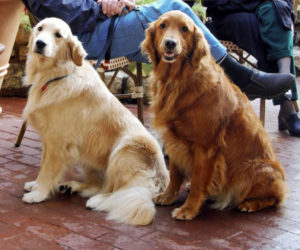 In the canine world, the retrievers take the crown. Retrievers are consistently one of the most popular dog types in the United States. Here in San Francisco, we love retrievers too! To be more specific, we are big fans of golden retrievers.
In the canine world, the retrievers take the crown. Retrievers are consistently one of the most popular dog types in the United States. Here in San Francisco, we love retrievers too! To be more specific, we are big fans of golden retrievers.
In our dog breed of the month article, you will learn the basic facts of these gorgeous dogs, why they make great best friends, and how you can be awesome buddies. There are also some cool facts about the breed, which will hopefully make you appreciate them even more. Are you ready to learn more about the golden retrievers? Then start reading now!
Labrador Retrievers Vs Golden Retrievers
Retrievers are often described as hunting dogs, but they are gun dogs, which means they retrieve the game hunters have already shot. Golden retrievers, in particular, delivered birds to hunters.
Of the various types of retrievers, Labradors and Goldens are the best known. Although they share certain characteristics, including shedding and exercise needs, they differ in regard to temperament, grooming requirements, and adaptability.
These differences may be attributed to their history. Labrador retrievers are easier to maintain and are more likely to adapt quickly since they were bred as working dogs. They are strong, determined, and exposed to harsh conditions. Golden retrievers, on the other hand, were gentlemen’s dogs. Although they were still hunting companions, they were also raised as pets.
Golden Retriever Features
According to the American Kennel Club, a standard golden retriever will have a beautiful undercoat and a dense coat which repels water. A golden retriever will be symmetrical and strong in appearance and grow up to 24 inches at the withers for males and 22.5 inches for females. As its name suggests, golden retrievers have coats which can be of varying shades of gold or yellow.
Although they are not the strongest biters, golden retrievers do bite. Fortunately, they have a soft mouth as they were trained to make sure the game arrived without damage. Golden retrievers can live between 10 and 12 years.
Golden Retriever Temperament
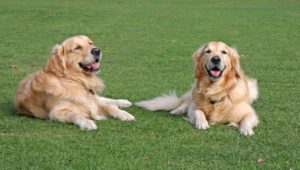 Golden retrievers tend to be trustworthy and friendly. They can easily adapt to their owner’s lifestyle, and they make great first pets since they are easy to train, forgiving, and obedient.
Golden retrievers tend to be trustworthy and friendly. They can easily adapt to their owner’s lifestyle, and they make great first pets since they are easy to train, forgiving, and obedient.
These dogs are gentle, not only in terms of appearance but also in terms of temperament. Although goldens do bark sometimes, especially at strangers, they are not hostile or aggressive. They are playful, cheerful, smart, and attentive, which makes them appealing to children.
Can a golden retriever be left alone for long periods? The answer is “yes, but it will be challenging.” Golden retrievers are known for being full of energy and needing stimulation often. If left alone for extended periods while you’re out and about all day, a golden retriever will become bored and even depressed. If you want to have a golden retriever, you should consider getting a sitter, buying those amazing tech tools that allows you to connect with your dog even when you’re out, or adopting an older dog.
Golden Retriever Grooming and Maintenance
Goldens are sturdy and athletic, requiring regular exercise. It is recommended you walk a golden retriever at least twice a day and/or engage them in play constantly. Their dense coat, which also makes them heavy shedders and therefore not “hypoallergenic,” means they will require regular grooming (at least once a week.)
A regular grooming schedule for your golden retriever will help you reduce the amount of hair they shed around the house. If you wish to groom your golden yourself, be sure to trim the hairs around his feet, ears, and tail. You should not shave a golden retriever. The nails should be trimmed and the ears cleaned. There’s no limit as to how many times in a month you can bathe the dog.
Golden Retriever Fun Facts
- While the Queen of England is known for her corgis, American Presidents Reagan and Ford had famous golden retrievers roaming the Oval Office.
- Adam Levine and Jimmy Fallon are huge golden retriever lovers.
- Bailey is probably one of the hottest golden retrievers these days with more than 16,000 followers on Instagram. You can follow him and keep up to date on his adorable antics.
- Golden retrievers are so active and playful, they will jump in a lake for a game of fetch. Don’t worry though, as they’re fabulous swimmers.
- Golden retrievers have appeared in many movies including Air Bud and the Homeward Bound series. (Is it because they’re easy to train and look incredibly cute in front of the cameras?)
Dogs are called man’s best friend, and golden retrievers embody many of the characteristics that people imagine when quoting that saying. A golden retriever is a well-behaved, happy, cheerful dog that can enhance your life with its intelligence, energy, and sweet, caring personality. Although raising one can have its challenges, such as grooming, dander, and need for stimulation, these can be managed provided you have the patience, determination, and love, which you sure do if you’re considering being a pet parent.
Read more like this:
Featured Dog

